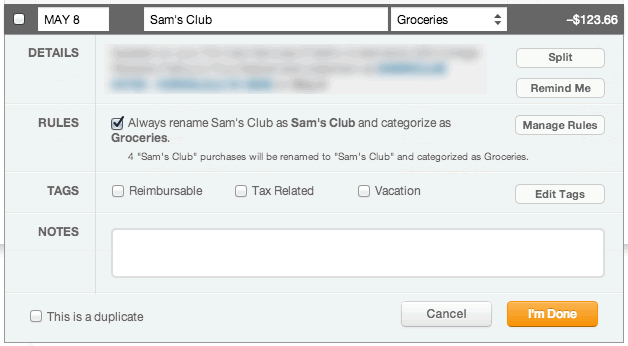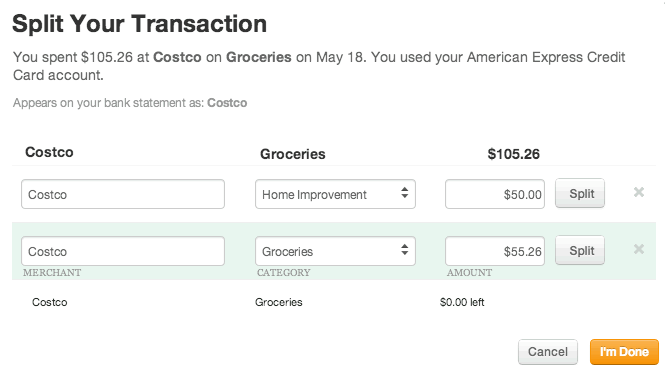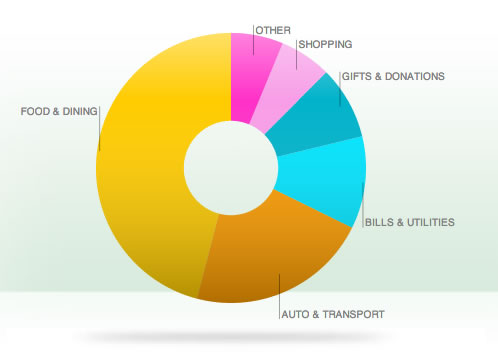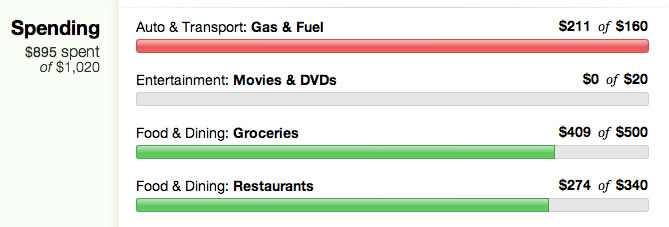 While I don’t believe everyone necessarily needs a tracked-down-to-the-dollar budget, I do think a major problem is that many people simply don’t know where their money goes. That makes it quite hard to know if your spending habits match up with your priorities. I’ve been using Mint.com (free, ad-supported) to track our household spending for a while. (I used to be a Yodlee guy, but they’ve been left behind with slow and clunky updates.) For those starting out, here are some practical tips that may be useful.
While I don’t believe everyone necessarily needs a tracked-down-to-the-dollar budget, I do think a major problem is that many people simply don’t know where their money goes. That makes it quite hard to know if your spending habits match up with your priorities. I’ve been using Mint.com (free, ad-supported) to track our household spending for a while. (I used to be a Yodlee guy, but they’ve been left behind with slow and clunky updates.) For those starting out, here are some practical tips that may be useful.
Using Credit and Debit Cards
The primary advantage of using a service like Mint.com is that if you pay for things with a linked credit or debit card, then important stuff like the date, merchant, and amount are immediately recorded so you don’t have to do it manually. No receipts, no typing, no writing. That’s a lot of time and mental energy saved.
Auto-categorization Training
After Mint imports your transaction information, it will provide its best guess as to the proper spending category. McDonald’s will be “Fast Food”, for example, but it also thought my water company was a clothing store. You can correct the category, and also create a rule that always changes the category to what you prefer. For example, I always set Sam’s Club and Costco as “Groceries” because that’s mostly what I buy there.
After a couple of months, you spend less and less time fixing categories. In general, I try to make things fit into just a few simple categories: Food, Auto, Utilities, and Shopping. (You can also manually enter cash purchases, but simply set all ATM withdrawals to be “Food/Restaurants” by default.)
Splitting Transactions
If I do buy something notable and non-grocery like a $50 faucet fixture or something at Costco, I can always split the transaction into two or more separate categories:
Exclude from Mint
There are some things that Mint doesn’t handle that well, or you simply don’t want Mint to track. For this, use the “Exclude from Mint” category. I prefer to have Mint ignore all my retirement account contributions, interbank funds transfers, and estimated tax payments. This cleans up the data and allows me to focus on the spending.
Trends
Out of all the top-level sections, I spend most of my time in “Trends”. That’s where the nifty charts live! I usually start with the “Spending by Category” pie chart. From here, I can edit individual transaction categories, see quickly if something is out of whack, and compare spending across different time periods.
Budgets and Alerts
If you’d like to set a spending target on certain categories like Restaurants or Shopping, then the Mint “Budget” section is nice because it can track your spending against the limits for you and even send an e-mail/text alert if you exceed it. If want to use this to continuously monitor your spending, I would recommend downloading their smartphone or table apps to make it easier to check in.
Security
You may be rightfully nervous about sharing your login credentials, but in my opinion your credit card login is not as sensitive as say, a bank login. Unauthorized credit card transactions are easily disputed, and these days it seems like online stores are more likely to lose your credit card details anyway. I’m less comfortable giving out my banking information, so I choose not to link my primary bank and investment accounts with Mint. (I do link some lesser-used accounts, just to keep an eye on them.) Mint.com is also owned by Intuit, makers of TurboTax, so they should have some experience in keeping personal data safe. I haven’t had any issues either way.




 The Best Credit Card Bonus Offers – 2025
The Best Credit Card Bonus Offers – 2025 Big List of Free Stocks from Brokerage Apps
Big List of Free Stocks from Brokerage Apps Best Interest Rates on Cash - 2025
Best Interest Rates on Cash - 2025 Free Credit Scores x 3 + Free Credit Monitoring
Free Credit Scores x 3 + Free Credit Monitoring Best No Fee 0% APR Balance Transfer Offers
Best No Fee 0% APR Balance Transfer Offers Little-Known Cellular Data Plans That Can Save Big Money
Little-Known Cellular Data Plans That Can Save Big Money How To Haggle Your Cable or Direct TV Bill
How To Haggle Your Cable or Direct TV Bill Big List of Free Consumer Data Reports (Credit, Rent, Work)
Big List of Free Consumer Data Reports (Credit, Rent, Work)
3 years later and I am still lamenting the loss of Microsoft Money. I used to have every single account, including brokerage, retirement, credit cards, banks, etc, tied to the penny and automatically updated daily with current valuations. Still struggling with horrible, clunky Quicken, I can’t believe they are behind Mint.com!
Any way, I would love to see what others are using and any reviews. I stumbled across a website that tries to keep Money alive by using python scripts to automatically query banks for transactions but couldn’t get it to work for me (not having the time to troubleshoot for hours).
You should be able to access the old version of Yodlee (the one before they introduced the finapps) via the time machine menu option.
I switched from Money to Quicken when Money was discontinued. Now using Q 2011 and have gotten acclimated to it.
One comment… I am always intrigued by the category “shopping”… Shopping for what? Could be shopping for groceries, autos, clothes, major appliances, etc.
I keep “Restaurants” separate from “Food” i.e. Groceries. They are two different things. And we separate out non-food items when purchased at the grocery store.
@Joshua – I haven’t been keeping up with desktop software, but have heard some good things about iBank for Mac users.
@Jeff – Thanks, I know, but Mint finally improved their syncing to be on par with Yodlee and their transaction system is just better now in my opinion. All the accounts I want now work with Mint, which wasn’t always true before.
@Warren – Shopping is like the “other” for more discretionary non-food items like books, music, apps, consumer electronics & accessories, clothing, sporting goods, hobbies. I agree on separating groceries and restaurants, I do that in Mint as well.
Mint – good for tracking spending, absolutely HORRIBLE for tracking investments.
Bug-ridden code. I have used it for about four years and for nearly that entire time, there have been on-going and recurring bugs in the investments area of the tool, all of which have been reported with screen caps and thorough explanations and the typical support experience ends with someone from Mint responding that they do see the error in the software and have escalated it up the engineering chain. I have one outstanding issue approaching two years now, with then regularly contacting me to say they have fixed it – I check and it is not, so I follow up with more documentation and they reply with the “escalating this up the engineering food chain” message. Read the support message boards before considering.
So, decent for tracking spending, absolute garbage for investments. Based on this experience, I would never actually buy anything from Quicken (too bad, I used to use Quicken products and liked them but their mishandling of Mint is a huge PR failure).
I created “Reconciled” tag to match receipts with transactions in Mint. Still, a dedicated reconciliation is much missed.
Have you used comparison tab in Investment section. Mine always shows red in comparison to SP500 (since 2011 or so). I tried DOW and NASDAQ, all red. No green. I never kept track of my returns. Mine was more index based and follows loosely Swenson model (or more or less couch potato or your portfolio model with Vanguard index funds (not ETF though). So I thought I should have rough 6-7% gain YOY. Not sure if I can trust mints comparison chart. May be I need dig deeper and look at my returns to figure out if its indeed showing the comparison correctly. Any thoughts?
Would appreciate if you can do a write up on that comparison and how one could use mints comparison chart once in a while to keep tab on performance of their portfolio and sleep well at night.
As one that has used Yodlee since ten years ago and simultaneously use Mint on the side, I have to say that Mint’s transaction categorization sucks balls compared to Yodlee. Yes, making your own rules is fine but it’s so frustrating when 20% of my transactions are uncategorized and need me to manually correct them. Yodlee’s algorithm has been way smarter and nearly no input is required for weeks at a time, no matter how small the mechant is. Just to give an example of the frustration, Mint often categorizes my stock trades like APPL as electronics or even food purchases just based off the name keyword in these transactions. I mean hello? This is from a brokerage account… Mint also is confused by capital gain distributions and transfers to my investment accounts.
Have to agree with Kevin about Mint’s transaction categorization – it is really coming apart these past few months.
Each Saturday, I get the weekly summary and each Saturday I have to log in to Mint to make corrections. That is okay when it is an item with a new vendor/store, but I am seeing mis-categorizations for items which have been repeated monthly (and categorized correctly) for years, which are now all over the map.
I guess Mint’s poor programmers have run out of things to muck on with the Investments tool and are now spending their summer working on the Transactions tool.
Mint is not perfect but think about *everything* that is doing for you…pulling transactions, deciphering vendors, assigning categories, and then aggregating it all in real-time into tabular and chart-based formats. For free! I think it’s the single most important webapp that I use. I am still a little queasy about the security aspects but, other than that, I have no complaints. (Former MS Money user.)
You get what you pay for.
The investment tracking has been full of bugs for years now, but the spending tracking was pretty solid until about a year ago. Since then, lots of misidentified transactions; long-standing, regular transactions being miscatagorized (the monthly mortgage payment – same date/same amount/same bank – for years was right, now gets assigned in any number of places, once under hobbies, once under kid’s expenses) and dropping connections with banks frequently when nothing has changed with the bank login information, requiring re-authenticating frequently.
Again, you get what you pay for. But I would never purchase a Intuit or Quickin product based on the Mint.com experience so far – if this was meant to get potential customers excited about moving into a pay model, they need to take Mint more seriously. Read their own customer support message boards before you consider Mint – and know that many of the “thread closed by Mint” notes on closed discussions are NOT because the problem was solved, but rather that such a long time had passed without a solution.
Honestly, I WANTED Mint to work well. It still could.
This is the best FREE program I have ever used. I agree there are some simple things it just won’t let you do like print your budget etc. It also about once a month has a connection issue with my bank and or is very slow. Another area I don’t like is once the month is over you can go back and make changes. For FREE I am very happy… I can’t believe Quicken / Intuit hasn’t screwed this webbased program up.